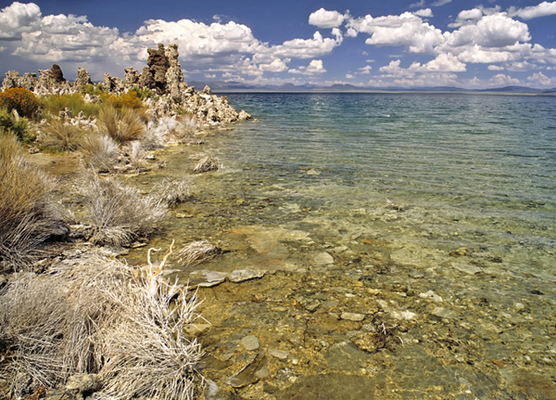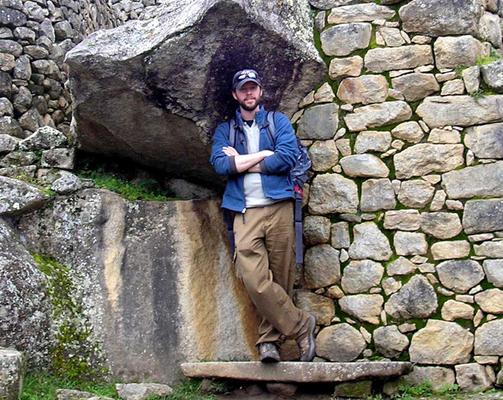
by Timothy Oleson Thursday, January 5, 2012

Last year, researchers claimed to find a bacterium in Mono Lake, Calif., that substituted arsenic for phosphorus. Michael Gibler, Creative Commons Attribution 3.0 Unported

Timothy Oleson at Machu Picchu in Peru. courtesy of Dave Clark
In reporting what’s new and exciting from the world of scientific and technological innovation, science writers are quick to use expressions like “Scientists say … " and “According to researchers … " (Mea culpa.) They are, after all, convenient devices to introduce the sentiments of some subset of the scientific community as opposed to one, or maybe several, individuals. Most consumers (and writers) of science news are probably astute enough to recognize a generalization when they see (or use) one, but it’s not hard to be lulled into forgetting that scientists are, of course, no more a monolithic group than any other profession. Similarly, members of individual scientific disciplines are hardly homogenous. Again, however, it is easy to forget or neglect this fact and fall back on blanket assessments out of convenience, even for scientists.
For an unfortunate example of a little scientist-on-scientist generalization, we can look to the Internet and the Great #ArsenicLife Affair of 2010-2011 (or G#ALA as I’ve termed the melee).
But first, a brief history: G#ALA was spawned late last fall with the emergence of a study to be published in Science that purported to offer evidence of a microbe that could not only thrive in the presence of high arsenic concentrations, but that could actively substitute the often toxic and usually unstable element for phosphorus — one of the six elemental building blocks of all known life — in its DNA. As the study’s authors pointed out in the abstract, “Exchange of one of the major bioelements may have profound evolutionary and geochemical significance.” With added pre-publication hype that the discovery “will impact the search for evidence of extraterrestrial life,” (according to NASA’s Astrobiology Program, which, in part supported the work), the study immediately attracted gobs of media attention. (”#arseniclife” is the accepted Twitter moniker for all related chatter.)
The study also attracted attention from all manner of scientists, many of whom took to the web within days to enumerate a multitude of experimental and analytical flaws that they said invalidated the study’s most notable conclusions. The apparent in-fighting with the scientific community, aided by the reticence of the study’s authors to directly respond to the most pointed scientific critiques, provided fodder for science writers and scientist bloggers that gave the story legs for a few weeks, after which the buzz mostly quieted down.
Then, a few weeks ago, the melee got a second wind. Along with eight technical comments formally summarizing the major critiques of the study and a rebuttal from its authors, Science finally published the manuscript in print on June 3 (it had previously only been published online). And voilà … G#ALA, Act II.
In the second act, the technical critiques have been refined and restated. Additionally, this latest round of commentary has included reflections on how G#ALA’s legacy will not be the details of the contested research, but rather the broader lessons that it has brought to light.
First, there is the lesson that scientific agencies should be careful about over-hyping their claims. Second, there are lessons about how the Internet is changing “the way scientists do science” by providing a vast space for open post-publication peer review and by pulling back the curtain to expose the occasional messiness of scientific controversy. And finally, there are lessons for educators about how science, including the messy parts, could be better taught.
As a one-time biogeochemist and current science writer, I have had an avid, albeit passive to date, interest in the twists and turns of the #ArsenicLife story, scientific and otherwise. I’m inclined to agree that G#ALA has many lessons to offer, including those above that others have already suggested. But one recent blog post gave me pause.
In his blog commentary, molecular biochemist Steven Benner of the Westheimer Institute for Science and Technology and the Foundation for Applied Molecular Evolution, who also wrote one of the technical comments published in Science, details his case for how the paper’s authors failed to properly vet their data and the resulting conclusions against established standards. It’s a convincing case. He also correctly points out that responses by the study’s authors to critiques were, in many cases, incomplete at best. Mostly, though, he uses the study and the subsequent debate between the authors and critics as a case study to discuss his thoughts on how researchers in different scientific disciplines view “burdens of proof” and “standards of proof.”
In laying out his case in the blog, he refers to the study’s authors (several of whom were/are with the U.S. Geological Survey) collectively as “the geologists,” while the crusading critics become “the chemists.” These convenient simplifications make for a compelling and combative back-and-forth in a sort of “good guy, bad guy” manner, and for the most part, it is clear that he is using them to refer to the specific groups involved in the debate. For the most part.
Nearing the end of his exposition, he veers off track somewhat as his thoughts about the study’s authors merge into a few sweeping generalizations about “the geological community”:
To the geological community, extraordinary evidence is not required to accept the arsenate-DNA conclusion. To geologists, an “Occam’s razor” argument is sufficient based on “multiple congruent lines of evidence” that they themselves collected. Never mind the chemists’ databases. Arsenate-DNA is, in this view, the simplest explanation for the data extracted from GFAJ-1. So why not propose this structure? And get it published by Science, if you can?
His comments caught me off guard, and I was initially a little conflicted (due to my mixed chemistry/geology heritage). But what I took to be the implication — that geologists, on the whole, are simpletons, willfully ignoring chemists’ vast knowledge bases in order to score big in Science — bordered on offensive. I was evidently not alone, as several responses appearing below his blog attest.
One person pointed out that G#ALA is “not a clash of cultures between chemists and geologists. It’s a clash between one specific research group and the scientific community.” In another comment, Chris Rowan, who has previously written for EARTH, added that “it seems a little careless — and potentially inflammatory — to tar entire disciplines with the same sci-philosophical brush.” I agree wholeheartedly. To do so is obviously inappropriate and does little to foster mutual understanding and cooperation.
I doubt that Benner’s intent was actually to insinuate that geologists are somehow universally ignorant of chemistry or to imply that chemists are superior scientists. I suspect that he just got a little carried away with the G#ALA narrative that he had carefully crafted, and he veered into broad generalizations. In fact, after being “taken to the woodshed by my many geologist friends,” he did offer somewhat of an apology in a subsequent post:
My bad … Sagan’s aphorism (“extraordinary claims require extraordinary evidence”) was the focus of my [earlier] comment, not the naming of fields.
Nonetheless, naming (and stereotyping) fields is just what he did, and, at least for some readers, the misstep clearly overshadowed his otherwise valid main point. Casting entire scientific disciplines as monolithic groups, especially when there are negative connotations attached, merely serves to entrench old divisions and does a disservice to interdisciplinary collaboration — which is, after all, what many, including Benner’s own organization (according to its mission statement and rationale), see as the necessary future of science.
© 2008-2021. All rights reserved. Any copying, redistribution or retransmission of any of the contents of this service without the expressed written permission of the American Geosciences Institute is expressly prohibited. Click here for all copyright requests.